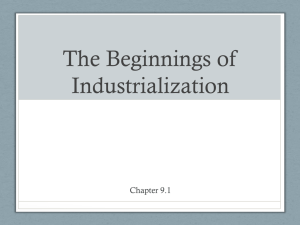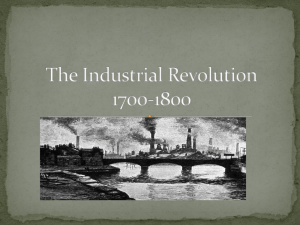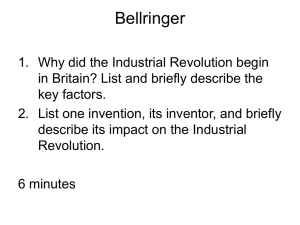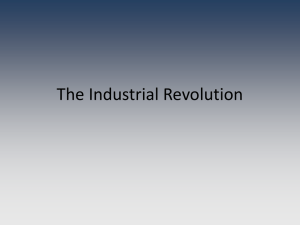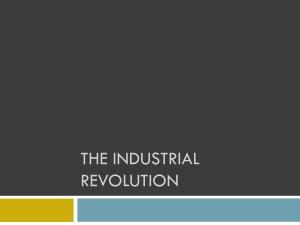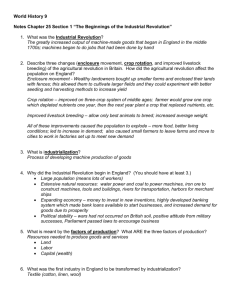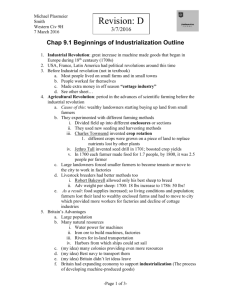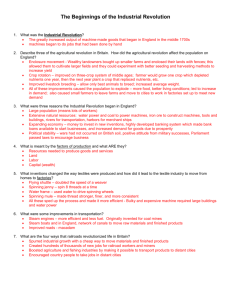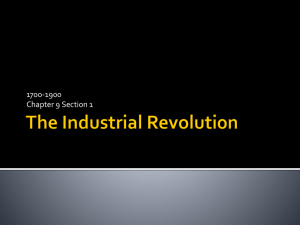Industrial Revolution
advertisement
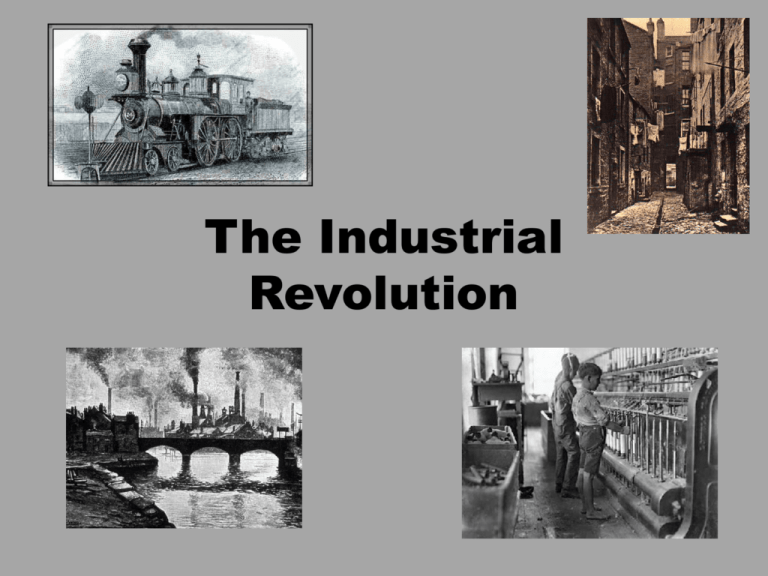
The Industrial Revolution Introduction • Unlike the French Revolution, the industrial Revolution was economic, having to do with the production of wealth, the techniques of manufacture, the exploitation of natural resources, the development of new technologies, the formation of capital, and the distribution of products to consumers • It would lead to the dominance of Britain, and Europe in General The Industrial Revolution in Britain • The process of shifting from hand tools to power machinery The Agricultural Revolution • The Glorious Revolution in England meant the ascendency of Parliament • In reality, this meant the landowning class would control parliament • This stability led to the Agricultural Revolution in England • This landowning class sought to increase profit through improved cultivation and stock raising • Example, the use of fertilizer such as manure, better inventions such as the horse hoe, new crops such, and included scientific ideas such as crop rotation • Additionally, science was applied – better breeding to produce larger cattle Enclosure Acts • Much of English land was still public, and was controlled by common rights • Since the landowners controlled parliament, they passed a series of acts that fenced them, and made them private • Because of this, small tracts of land could be gobbled up by large landowners, and it would be leased out to small farmers Labour Intensive vs Capital Intensive • This system, compounded with new inventions, freed up new labour, as farming became more efficient • Many farmers became wage earners, who worked for big farmers, or other jobs like weaving • They were also mobile, able to go where the work was because they were no longer dependant on the land Industrialism in Britain • Because Britain was so strong after the Napoleonic wars, they had the most colonies • Consequently, they had the most markets all over the world • The British merchant could sell as much as could be produced • They had to search for more rapid methods of production • Example, cotton. The demand for cotton was exceptionally high • The market was endless if it could be produced by machines • What was needed was capital – money to be invested • England had this because they were already wealthy from commerce and agriculture Key Inventions • 1733 – John Kay invents the Fly Shuttle • Meant that only one person was needed to weave cloth on a loom • Because output of weaving increased, demand for yarn increased • 1760s, spinning jenny invented • Steam engine invented for spinning • These machines were bigger, so Richard Arkwright set up the first mills, or factories, and brought the workers • Eli Whitney, 1793, invented the cotton Gin, which sped up the removal of cotton seed • This greatly increased the output of cotton • By 1820, Cotton made up ½ of British exports Steam Engine • Britain was running out of timber, so alternate sources of energy where needed • By 1780, Boulton and Watt were manufacturing steam engines for use • The steam engine went from use in factories, to transportation • Led to the development of railways • By 1840s, the era of railways was underway in Europe and the US New Industrial Cities • In population, Manchester grew from 25000 in 1772 to 455000 in 1851 • But incorporation of a new city was difficult because it was unusual. Therefore, new cities had difficulty with infrastructure, such as sewage • New cities were dreadful places • Blackened by the early coal age • Housing for workers was hastily built • And always in short supply • Entire families lived in single rooms Factories and Workers • Most factories only required unskilled labour • Skilled workers, such as weavers, had been displaced by machines, and looked for any odd job • Factories paid wages that were too low to allow a man to support his wife and children • The work was so mechanical, that the work of children was often preferred • Hours in factories were long, 14 plus hours a day • Not new to farmers, but the conditions were more repressive • Unorganized, bargained independently with employers • The owners, who were small business people, faced competition, and them too were in debt • They held wages to the lowest possible amount • Some regulation was in motion, such as the first Factory Act of 1802, which regulated the use of pauper children • But, there were no factory inspectors • Mainly, the new industrialists wanted to be left alone Affects of Industrial Revolution The Industrial Revolution created a new working class The new class of industrial workers included all the men, women, and children labouring in the textile mills, pottery works, and mines Wages were low, hours were long, and working conditions unpleasant and dangerous Women and children regardless of where they worked, had the most exploitative working condition and the lowest rates of pay. Houses were built in rows or in squares with a common courtyard, in which there might be a water tap and a common toilet. There was little access to fresh air and little provision for clean water or removal of refuse, including human waste. Classical Economics: Laissez Faire • 1776, Adam Smith Publishes “Wealth of Nations” • Criticized mercantilism • Natural laws of production and exchange should be allowed to rule • Economics runs outside of government • Natural laws of supply and demand • People such use their rational thought because they know their natural interests better than anyone else • The natural interests will add up to the interests of all • Government should provide laws and courts • Iron law of Wages – workers should only be paid at the subsistence level, because if they make more, they have more children, and eat up the extra money
